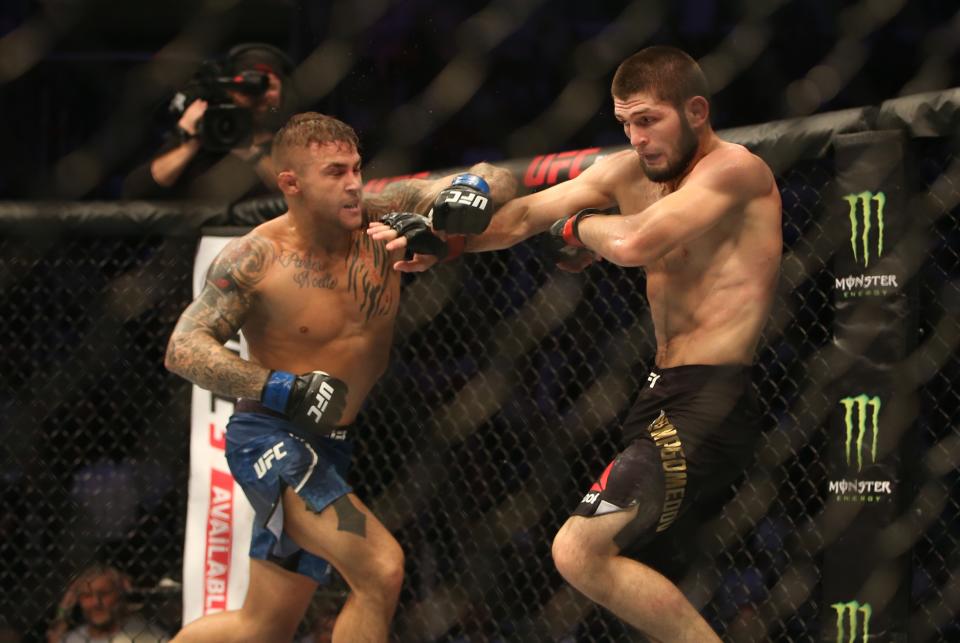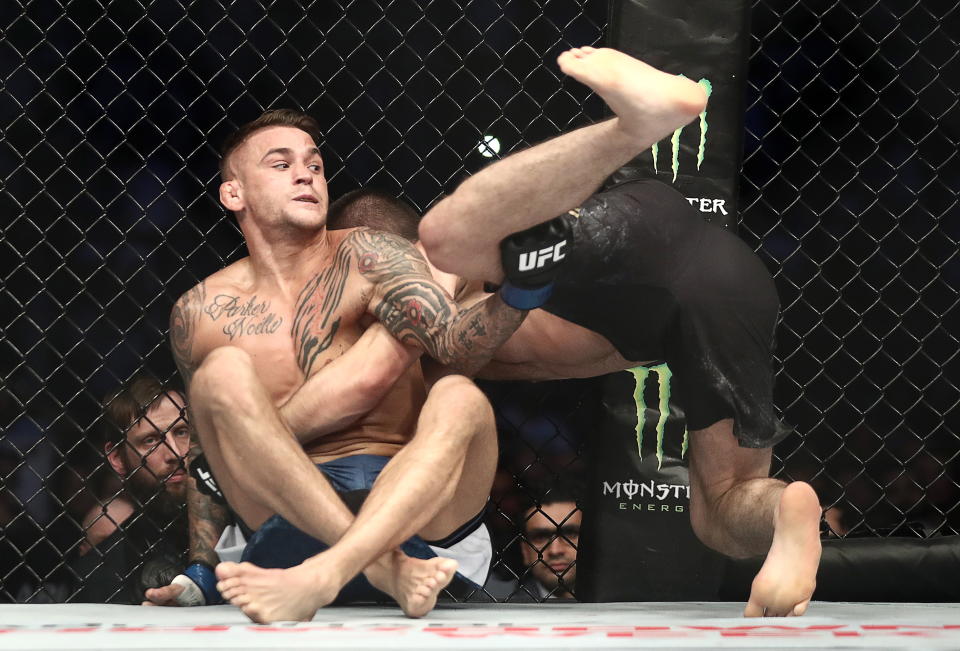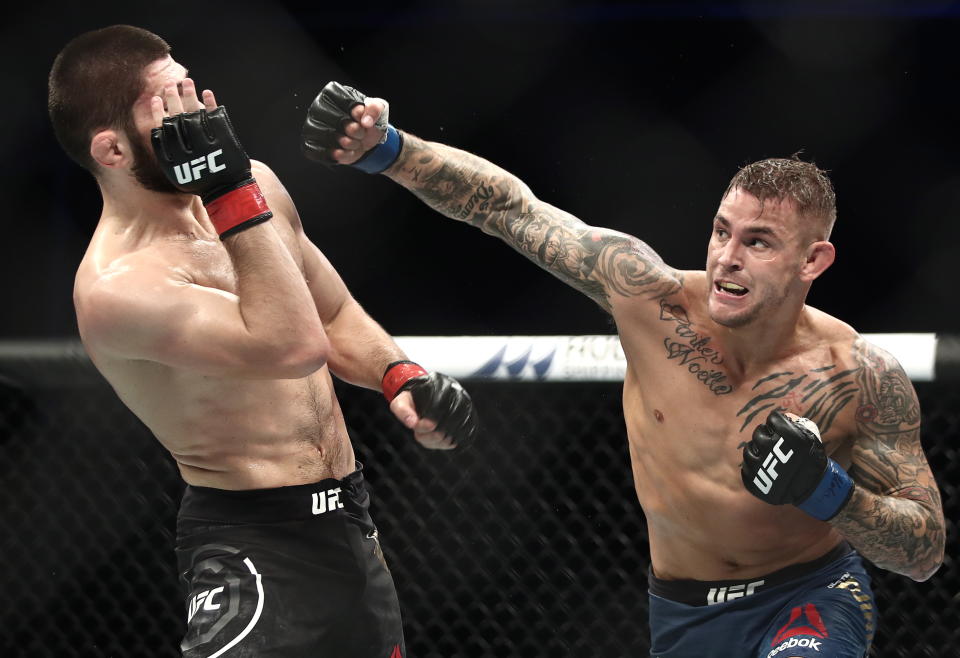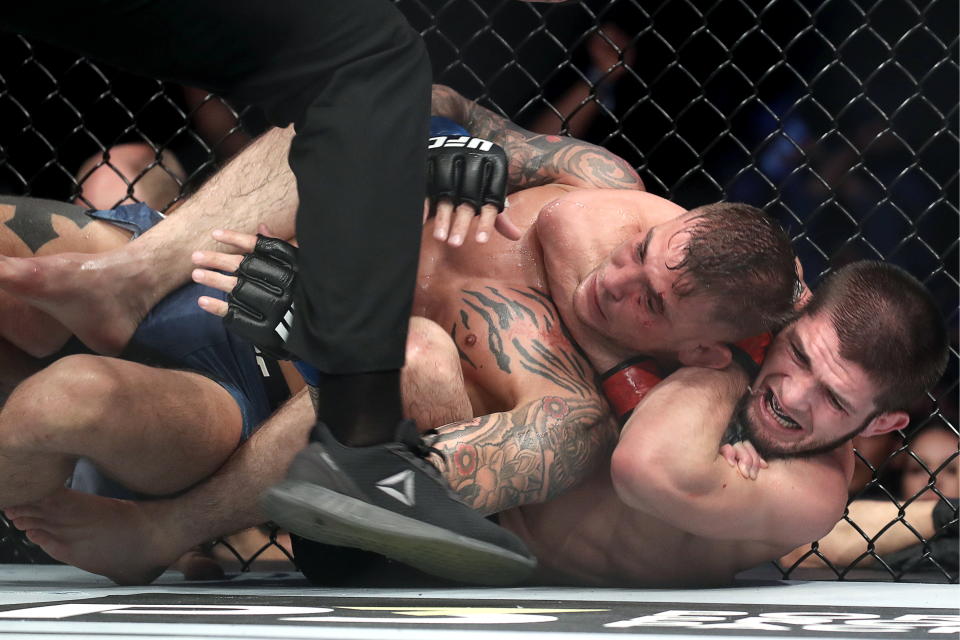What Dustin Poirier did well at UFC 242, and why Khabib Nurmagomedov still won

Another fight and another win for Khabib Nurmagomedov. The undefeated lightweight world champion improved his record to 28-0 after submitting Dustin Poirier last week at UFC 242.
Still, despite his impressive winning performance, Nurmagomedov admitted that Poirier came close to submitting him.
“Dustin’s guillotine was deep,” Nurmagomedov said of the challenger’s third-round submission attempt.
Prior to that strangulation attempt from Poirier, he also scored a few big punches to the head of Nurmagomedov. Though “The Eagle” recovered, defended and then took control superbly, Poirier’s effort warrants at least a bit more closer examination.
Doing well against Nurmagomedov has become a relative thing, since no one has yet to cleanly beat him. Still, Poirier appeared to come closer to finishing the Dagestani than any previous opponent.
So, here’s what Poirier did well, at UFC 242, and how Nurmagomedov still won:
Poirier stayed calm on the ground

Poirier and his team knew that Nurmagomedov would try to get in on his legs and hips and attempt to take him down, over and over again. They also likely knew that, despite their best efforts, he’d succeed in putting Poirier on his back at some point.
Indeed, Nurmagomedov put Poirier down early in the fight. Once there, he looked for the kill immediately as well.
"At his mauling best in round one!" 🦅
🏆 The champ is in prime form! #UFC242 pic.twitter.com/T7sIHTmV14— UFC (@ufc) September 7, 2019
Though the champion was successful in keeping Poirier down, controlling him, and threatened with an early choke, Poirier managed to survive. He did so largely on the strength of his calm and composure.
At no point, early, or late in the fight, even when Nurmagomedov managed to submit him, did Poirier look desperate or as though he wanted a way out of the bout. He fought Nurmagomedov’s hands gamely when he controlled a wrist, and when he attempted strangles.
Poirier didn’t give Nurmagomedov any major holes, and the wrestler was able to eventually find his finishing hold because of his technique, not because Poirier had given in, lost focus, or in anyway panicked, from the looks of things.
Poirier found chances to land in favorable spots
When the takedown is pretty much inevitable, as it is when fighting Nurmagomedov, one has to try and at least make him work for it, do damage as he closes the distance and try to hit the ground in a manner that still allows for the possibility of offense.
Poirier wasn’t able to find any uppercuts to endanger a level-changing Nurmagomedov, really (as most of his strikes were straight or wide and high), but he did look to capitalize on any posture problems of Nurmagomedov’s as he worked for takedowns. From the start, while pinned against the fence and feeling the inevitability of a takedown, Poirier worked for front headlocks.
In the third round, Poirier managed to snatch Nurmagomedov’s head and neck well, and when he was subsequently taken down, he managed to angle away from the cage, preventing being pinned against it and to allow himself the possibility of achieving the angles he needed to finish the strangle.
Poirier fought takedowns, but also knew when to bail on that defense and work to set himself up well in the next stage of the fight. The way he did this in third round got him close to winning the world title.
When back on his feet, Poirier went for the finish

It is common for great strikers to be reluctant to fire away with snap and power on the feet against dominant wrestlers, because they worry about being put on their back in the process and kept on the ground afterward. This is something heavyweight takedown king Curtis Blaydes explained to us well last week.
In this way, great wrestlers can make great stand-up strikers a lot less effective, simply by using precaution as a way of making the dangerous strikers less offensive-minded. For Poirier to have had a chance against Nurmagomedov, he would need to throw his punches while straddling the line of being aware and doing what he could with timing and distance to not make takedowns easy for his opponent, and still throwing strikes aggressively.
He did just that. What’s more, he had the physical conditioning and mental focus to continue to do so even after being dominated on the ground and tired out.
Poirier’s other big moment in the fight came before his guillotine choke attempt and after getting a chance back up on his feet against Nurmagomedov. He was doubtless tired, frustrated, and wary of being taken down again.
Still, Poirier gave himself a shot to win by aggressively stalking and firing punches at Nurmagomedov. He cracked the champion a couple times, visibly hurt him, and proved that he had a stronger mentality than most.
OOOOOOOOH! 😱@DustinPoirier tags the Khabib! #UFC242 pic.twitter.com/c9M7YE8wda
— UFC (@ufc) September 7, 2019
Just as the later choke might very well have finished Nurmagomedov, any one of those big punches from Poirier could very well have been a fight-ender for him. Knowing one’s hypothetical routes to victory is mostly an exercise of intelligence.
Having the guts to actually set out on those routes and stay on them, no matter how dangerous they get, is one of courage and conditioning meeting smarts. Poirier showed all of that.
Why Nurmagomedov still won
Giving a worthy challenger like Poirier his due after defeat is important. So is recognizing a few details of the champion’s in-cage greatness.
Nurmagomedov has won most of his fights without really ever being threatened. At UFC 242, however, he was hit soundly on the feet and threatened by a deep strangulation hold on the mat.
Yet, he prevailed. Here’s a few general reasons why:
He got to the wall
Nurmagomedov may be the best wrestler in the sport of MMA, but he’s not very good out in the open. That is to say, he’s best at scoring takedowns after pinning his opponents against the fence.
He’s also best at controlling them on the ground when they’re near the fence. Out in the open, the center of the Octagon, Nurmagomedov’s takedown entries are well-timed, but basic and certainly not without their holes and vulnerabilities.
Once Nurmagomedov makes contact with an opponent, he is good at chain-wrestling, and using second, third and fourth efforts to get himself into position to finish a takedown. He often needs to end up on the wall to finish.
Poirier was certainly aware of this and tried to stay away from the cage. Nurmagomedov found a way to press him there repeatedly, however. Had he not been able to, Poirier would have likely been more effective at defending takedowns and getting back up and away after being downed.
Nurmagomedov was smart and patient
There’s a lot of technical things that Nurmagomedov did well while caught in Poirier’s guillotine in the third. For starters, he relieved pressure and created space by rolling to his own side and scooting away at just the right times.
Still, what allowed him the opportunity to try the right things, technically, was a poised and calm mind that likely didn’t have the idea of submitting anywhere near it at the time. To escape, Nurmagomedov had to risk giving up position, and had to likely go through some scary moments with no or quite restricted breathing.
Once he escaped guillotine, he seized his moment

Lesser fighters might have taken a break and a moment’s rest after escaping such a dangerous choke as Poirier had ensnared Nurmagomedov in. The champion, however, immediately moved right to the goal of advancing position and setting up his own finishing move.
Moments later, he had secured a submission win. After trying so hard to finish his guillotine choke, Poirier was likely quite tired, both in cardiovascular and muscle endurance categories.
If Nurmagomedov had rested after being so close to being finished it might have felt good to him, but Poirier would have also gotten time to rest and recover. Instead, Nurmagomedov left rest for later and jumped on his opportunity, securing an even more dominant position and working for his own choke from behind before Poirier could recover.
More from Yahoo Sports:

